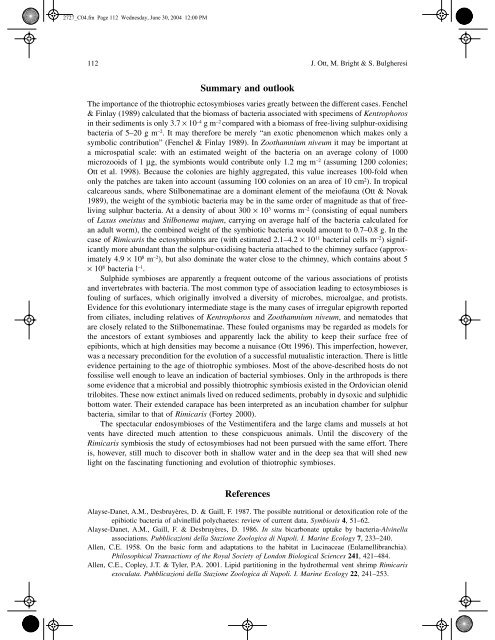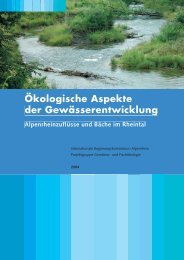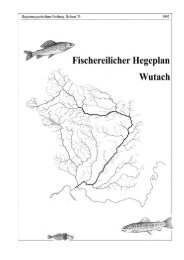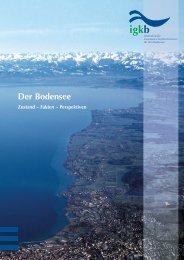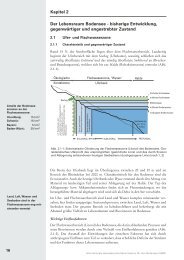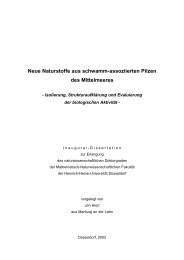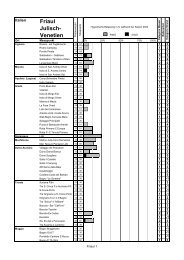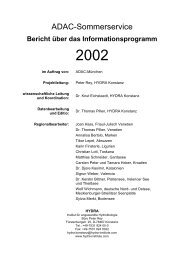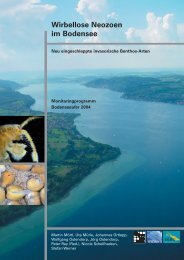marine microbial thiotrophic ectosymbioses - HYDRA-Institute
marine microbial thiotrophic ectosymbioses - HYDRA-Institute
marine microbial thiotrophic ectosymbioses - HYDRA-Institute
Create successful ePaper yourself
Turn your PDF publications into a flip-book with our unique Google optimized e-Paper software.
2727_C04.fm Page 112 Wednesday, June 30, 2004 12:00 PM<br />
112 J. Ott, M. Bright & S. Bulgheresi<br />
Summary and outlook<br />
The importance of the <strong>thiotrophic</strong> <strong>ectosymbioses</strong> varies greatly between the different cases. Fenchel<br />
& Finlay (1989) calculated that the biomass of bacteria associated with specimens of Kentrophoros<br />
in their sediments is only 3.7 ¥ 10 –4 g m –2 compared with a biomass of free-living sulphur-oxidising<br />
bacteria of 5–20 g m –2 . It may therefore be merely “an exotic phenomenon which makes only a<br />
symbolic contribution” (Fenchel & Finlay 1989). In Zoothamnium niveum it may be important at<br />
a microspatial scale: with an estimated weight of the bacteria on an average colony of 1000<br />
microzooids of 1 mg, the symbionts would contribute only 1.2 mg m –2 (assuming 1200 colonies;<br />
Ott et al. 1998). Because the colonies are highly aggregated, this value increases 100-fold when<br />
only the patches are taken into account (assuming 100 colonies on an area of 10 cm 2 ). In tropical<br />
calcareous sands, where Stilbonematinae are a dominant element of the meiofauna (Ott & Novak<br />
1989), the weight of the symbiotic bacteria may be in the same order of magnitude as that of freeliving<br />
sulphur bacteria. At a density of about 300 ¥ 10 3 worms m –2 (consisting of equal numbers<br />
of Laxus oneistus and Stilbonema majum, carrying on average half of the bacteria calculated for<br />
an adult worm), the combined weight of the symbiotic bacteria would amount to 0.7–0.8 g. In the<br />
case of Rimicaris the ectosymbionts are (with estimated 2.1–4.2 ¥ 10 11 bacterial cells m –2 ) significantly<br />
more abundant than the sulphur-oxidising bacteria attached to the chimney surface (approximately<br />
4.9 ¥ 10 8 m –2 ), but also dominate the water close to the chimney, which contains about 5<br />
¥ 10 8 bacteria l –1 .<br />
Sulphide symbioses are apparently a frequent outcome of the various associations of protists<br />
and invertebrates with bacteria. The most common type of association leading to <strong>ectosymbioses</strong> is<br />
fouling of surfaces, which originally involved a diversity of microbes, microalgae, and protists.<br />
Evidence for this evolutionary intermediate stage is the many cases of irregular epigrowth reported<br />
from ciliates, including relatives of Kentrophoros and Zoothamnium niveum, and nematodes that<br />
are closely related to the Stilbonematinae. These fouled organisms may be regarded as models for<br />
the ancestors of extant symbioses and apparently lack the ability to keep their surface free of<br />
epibionts, which at high densities may become a nuisance (Ott 1996). This imperfection, however,<br />
was a necessary precondition for the evolution of a successful mutualistic interaction. There is little<br />
evidence pertaining to the age of <strong>thiotrophic</strong> symbioses. Most of the above-described hosts do not<br />
fossilise well enough to leave an indication of bacterial symbioses. Only in the arthropods is there<br />
some evidence that a <strong>microbial</strong> and possibly <strong>thiotrophic</strong> symbiosis existed in the Ordovician olenid<br />
trilobites. These now extinct animals lived on reduced sediments, probably in dysoxic and sulphidic<br />
bottom water. Their extended carapace has been interpreted as an incubation chamber for sulphur<br />
bacteria, similar to that of Rimicaris (Fortey 2000).<br />
The spectacular endosymbioses of the Vestimentifera and the large clams and mussels at hot<br />
vents have directed much attention to these conspicuous animals. Until the discovery of the<br />
Rimicaris symbiosis the study of <strong>ectosymbioses</strong> had not been pursued with the same effort. There<br />
is, however, still much to discover both in shallow water and in the deep sea that will shed new<br />
light on the fascinating functioning and evolution of <strong>thiotrophic</strong> symbioses.<br />
References<br />
Alayse-Danet, A.M., Desbruyères, D. & Gaill, F. 1987. The possible nutritional or detoxification role of the<br />
epibiotic bacteria of alvinellid polychaetes: review of current data. Symbiosis 4, 51–62.<br />
Alayse-Danet, A.M., Gaill, F. & Desbruyères, D. 1986. In situ bicarbonate uptake by bacteria-Alvinella<br />
associations. Pubblicazioni della Stazione Zoologica di Napoli. I. Marine Ecology 7, 233–240.<br />
Allen, C.E. 1958. On the basic form and adaptations to the habitat in Lucinaceae (Eulamellibranchia).<br />
Philosophical Transactions of the Royal Society of London Biological Sciences 241, 421–484.<br />
Allen, C.E., Copley, J.T. & Tyler, P.A. 2001. Lipid partitioning in the hydrothermal vent shrimp Rimicaris<br />
exoculata. Pubblicazioni della Stazione Zoologica di Napoli. I. Marine Ecology 22, 241–253.


